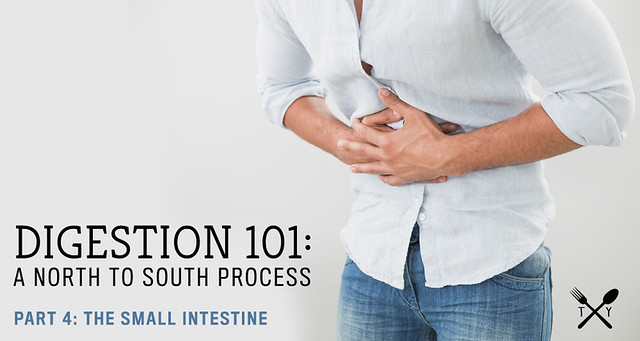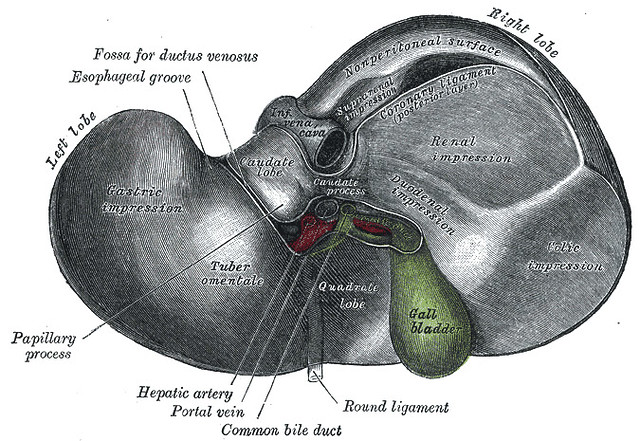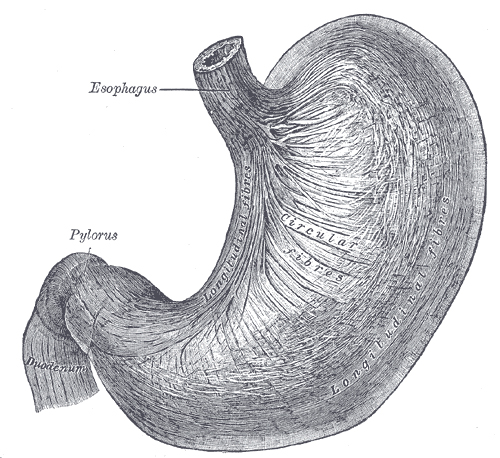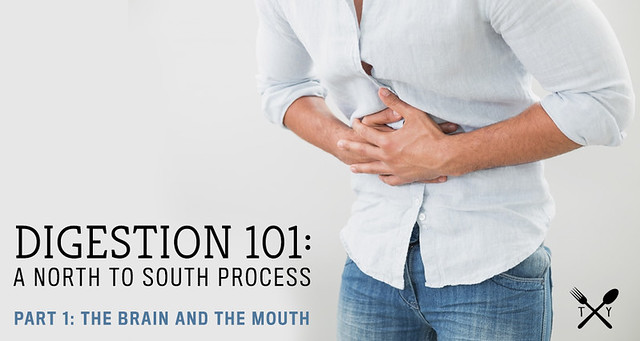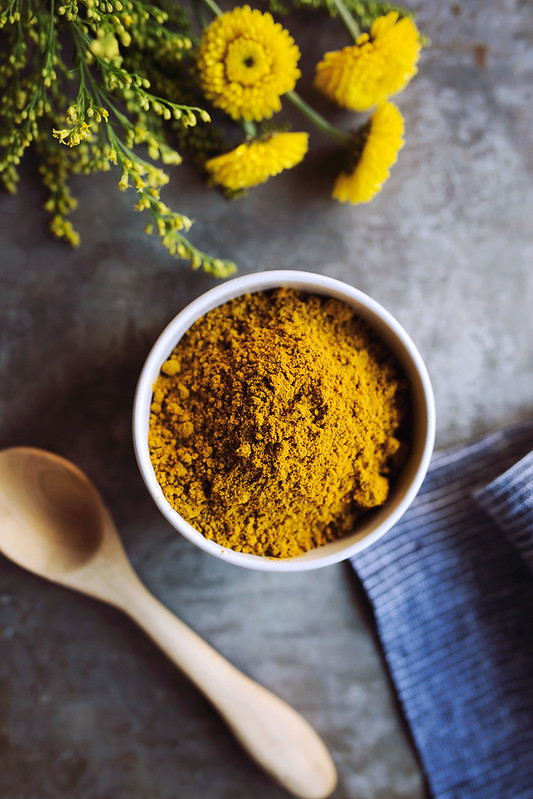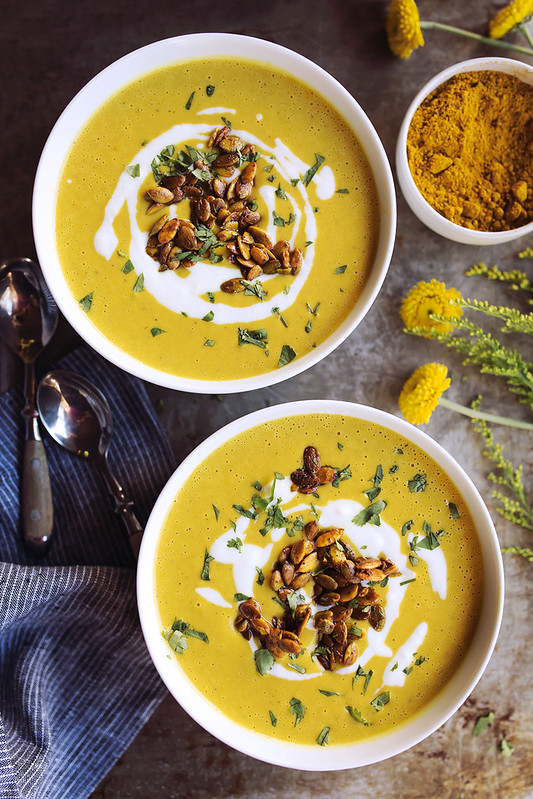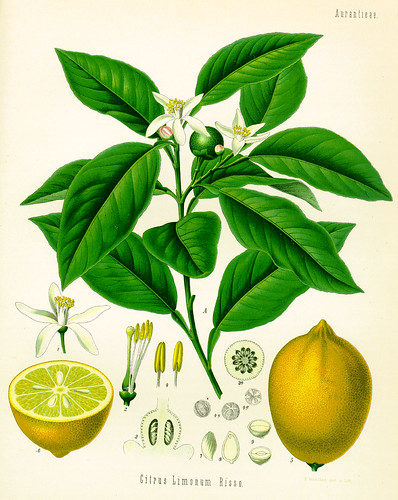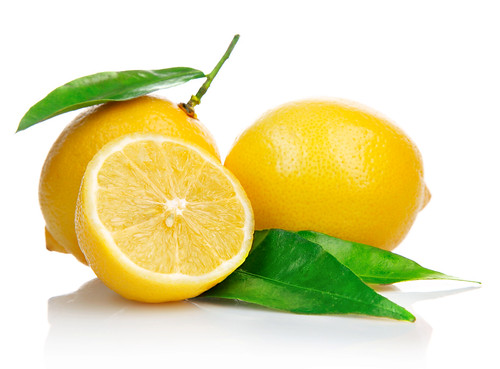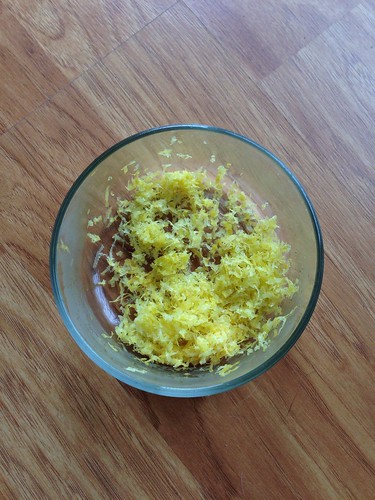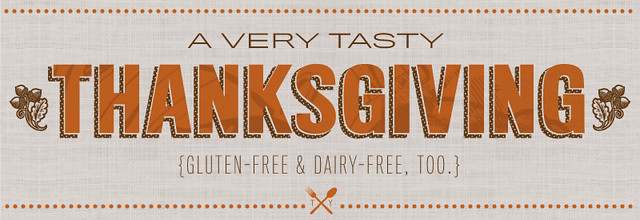-
Digestion 101: A North to South Process // Part 5: The Large Intestine
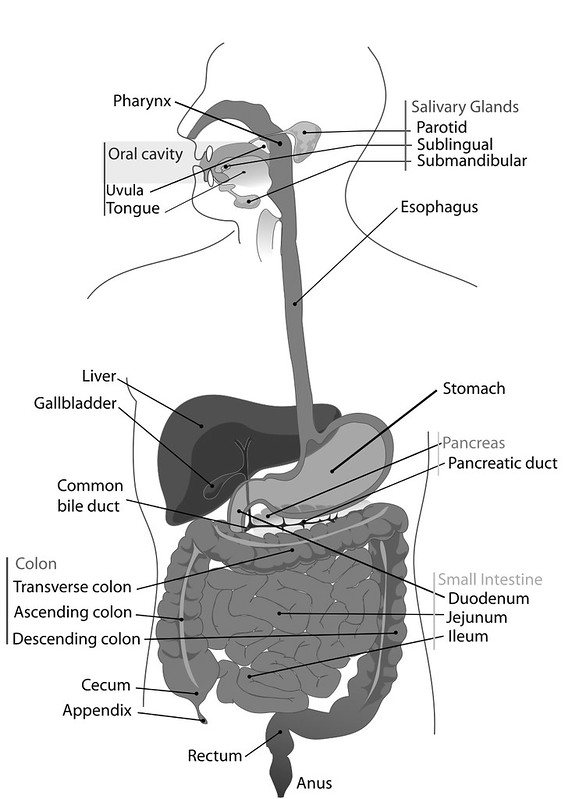
Digestion 101: A North to South Process
Here we are, at the end of the road. The large intestine is the final step in the process of digestion. By this point you probably more than understand the concept of digestion being a north to south process. We have talked about it at length starting first the brain and the mouth, and the importance of being in a parasympathetic state and properly chewing your foods, then of course the stomach and the dire need for proper hydrochloric acid production, how the accessory organs, the pancreas, liver and gallbladder continue the process of digestion, releasing bile, enzymes, various hormones and allowing the small intestines to finish digestion but more importantly do it’s very important job of assimilating nutrients and finally last but not least, the large intestine.
See Part One: The Brain and The Mouth
See Part Three: The Accessory Organs: Pancreas, Gallbladder and Liver
See Part Four: The Small Intestine
How it Should Work
The large intestine, or the bowel, is compromised of 3 sections, the cecum, colon and the rectum. The leftover chyme from the small intestines, passes through the illeocecal valve and first into the ascending colon. At this point in a healthy digestive system, what is left as chyme (the digested food) after the small intestines, is indigestible fibers, lots of water, sloughed off cells and bile. The large intestine is all about absorption and recycling.
As in the esophagus and the small intestine, the contents of the large intestine are pushed forward by a sequence of muscular contractions called peristalsis (a type of motility or muscular movement). After passing through the illececal valve the remains travels from the ascending colon, across the transverse colon where waste forms, into the descending colon, to the sigmoid colon and then the stool moves out of the body.
-
Digestion 101: A North to South Process // Part 4: The Small Intestine

Digestion 101: A North to South Process
As we continue more south in digestion, after first the brain and the mouth, then the stomach we move from the first part of the small intestines, the duodenum and it’s interaction with the accessory organs, the pancreas, liver and gallbladder and into the function of the small intestine.
After we leave the duodenum, the small intestine is less about the actual process of digestion, from a sense of breaking down the food we eat and it is more about the assimilation and absorption of nutrients.
The first part of the small intestines, the duodenum, acts more as a part of the stomach than the small intestine and the jejunum, ileum and villi are responsible for assimilation.
See Part One: The Brain and The Mouth
See Part Three: The Accessory Organs: Pancreas, Gallbladder and Liver

How it Should WorkThe small intestines have a dual role as an organ and a gland.
As we talked about in the previous post, The Accessory Organs – The Pancreas, Gallbladder and Liver, the small intestine releases mucous to keep things moving and it also releases two hormones: secretin and cholecystokinin.
Secretin stimulates the pancreas to release bicarbonate to lower the pH of the chyme and pancreatic juice. The CCK stimulates the gallbladder to release bile (to read more about these processes please see post #3).
By the time that the chyme has left the duodenum, thanks to the processes of the accessory organs, the chyme should be almost entirely digested.
- The carbohydrates have been broken down into glucose molecules
- Proteins are broken down into amino acids and polypeptides
- Fats are broke down into fatty acids and glycerol molecules
Peristalsis, a series of wave-like muscle contractions moves these absorbable molecules into the jejunum and the ileum, the middle and end parts of the intestine.
Within the small intestines, we have millions of villi, tiny finger-like projections that protrude from the epithelial lining of the small intestines. These villi and their microvilli absorb the nutrient molecules directly into the bloodstream, where they are carried throughout the entire body.
-
Digestion 101: A North to South Process // Part 3: The Accessory Organs – Pancreas, Gallbladder and Liver
Digestion 101: A North to South Process
As we continue more south in digestion, after first the brain and the mouth and then the stomach we move onto the accessory organs, the pancreas, liver and gallbladder
As we move further south from the stomach, while the small intestines are next in line for the food, but we first take a small pause/detour to discuss “the accessory organs of digestion”. The pancreas, liver and gallbladder, each play a very important role in the digestive process and each can be affected with their own dysfunction as well.
The stomach, small intestines and large intestines are all part of the system of digestion we call “the alimentary canal”, “the gut tube” or “digestive tube”. Between each of these organs we have valves or sphincters that keep the food where it is supposed to be and move it along when the time and the environment is right. These accessory organs are not a part of this tube or system but they play a major role in the process.

There is a synergistic and symbiotic relationship with the small intestines and these accessory organs, so we will discuss first how these play a role before we move into the function of the rest of the GI tract.
The duodenum is the start of the small intestine, but it almost acts more as part of the stomach, in it’s roles of breaking things down further playing a larger part in the process of digestion, vs the rest of the small intestine being less of a digestive organ and more about absorption or assimilation.
See Part One: The Brain and The Mouth
THE PANCREAS, GALLBLADDER AND LIVER:
How It’s Supposed to Work
When the pH of the chyme (the digested food moving from the stomach into the small intestines) is in it’s normal range, 1.5 – 3.0 , which we talked about in the stomach post. This is very acidic and necessary to the stomach performing it’s duties. As it hits the pyloric valve and into the duodenum with it’s proper pH, this is where the roles of the accessory organs come into play. This highly acidic chyme is what triggers these functions.
The duodenum no longer wants this highly acidic chyme and in order for the enzymes to work correctly it has to take that chyme to a neutral pH of 7.0. This happens by way of sodium bicarbonate, which is released by the pancreas to alkalinize the chyme. This release of sodium bicarbonate is signaled by secretin, a hormone released by the small intestines, which as you might have already guessed, is triggered by the (proper) acidic level of the chyme, that pH of 1.3 – 5. (Ahem, here is that reminder to look north, if the stomach isn’t producing proper HCl, then none of this will function properly, either!!)
-
Digestion 101: A North to South Process // Part 2: The Stomach
Digestion 101: A North to South Process
As we continue more south in digestion, after the brain and the mouth, next up we have the stomach. Before we get started, I wanted to remind you that you will constantly hear me reiterate as we go through this step-by-step process to “always look north” and I want you to truly understand what this means, exactly. I am referring to the fact that often times dysfunction that presents itself from further down the line, is actually due to a malfunction more north. For example, as you will read about in this second post and as we talked about briefly in the first, (the brain and the mouth), if you are eating in a stressful state and your body doesn’t make the necessary switch to that parasympathetic mode (rest and digest), then before your stomach ever had a chance to function properly, the brain basically threw it under the bus. So, while the symptoms may present themselves in the stomach (or even further south) it may not make sense to supplement, treat or approach the symptoms specifically until we instead move more north to investigate if these malfunctions are treatable with just some simple lifestyle and mindset shifts.

This is not at all to say that all digestive dysfunction starts in the brain, that would make my job and my own healthy journey so much simpler. In fact, there are many reasons why dysfunction can exist, as you will see, but beginning the investigative process at the start, way up north, allows us to rule out the possible, more simple resolutions before we move deeper and into more challenging treatments.
See Part One: The Brain and The Mouth
THE STOMACH:
How it’s Supposed to Work
After we chew our food, it turns into what we call a “bolus”. The bolus passes through the esophagus and the cardiac valve (the lower esophageal sphincter) and the bolus then enters our stomach, At this stage gastric juices are released. I like to think of the stomach as a blender. Mucous, pepsin and hydrochloric acid are all released for the “churning and burning” stage of digestion. Both mechanical and chemical breakdown happens at this stage.
The hydrochloric acid (HCl) being the most important of these gastric juices as it creates an acidic environment that disenfects the food and aids in the breakdown. Despite popular belief the stomach is absolutely meant to be acidic. In a healthy individual the pH of the stomach during digestion should drop to 1.5 to 3. We have a thick mucosal layer in our stomach, that acts as a barrier that protects the cells from the acid.
-
Digestion 101: A North to South Process // Part 1: The Brain and the Mouth
As many of you know, my digestion has been the source of much on and off distress over many years of my life. While I found the greatest relief by going 100% gluten-free after discovering an intolerance over 11 years ago, my digestion in the time since, has still not been without challenge and discomfort and at times, straight pain. As I began the journey to heal my body of my newly discovered autoimmune condition last year, we first needed to address my still, not-so-great digestion. This foundational approach to the healing of consequences, such as autoimmune conditions, by first treating digestive dysfunction – is a common approach, especially for functional and naturopathic doctors and nutritionists, who know that without properly functioning digestion, we cannot expect to ever find health and vitality. Without proper digestion we can be sure that we aren’t going to adequately assimilate the necessary nutrients through the food we are eating, no matter how healthy we eat and no matter what supplements or medications that we take. In working with a naturopathic doctor, we discovered early last year that I was struggling with leaky gut, and even found at the start of this year, after a year of dealing with the leaky gut, yet still not feeling 100%, that I had an unwelcome parasite and an excess of pathogenic bacteria (both likely the results of having a leaky gut, for who knows how long). It’s been a long year, to say the least.
Through the process of my own personal journey, I have and I continue to learn so much about digestion. This personal, ongoing path towards healing and all of the knowledge and know-how I have collected along the way, is what ultimately prompted me to go back to school to become a certified nutritional therapist. I wanted to truly learn and understand all of this in much deeper and fuller way, to allow me to not only continue to help and heal myself and my loved ones, but to also share this knowledge with others and hopefully help them help themselves, in the process.
So much of what we have been learning in school, about nutrition and more specifically, digestion, has really struck home for me. Much of what we cover are very simple concepts that I truly believe most people need to understand, and support – all of this ultimately has inspired me to share with you guys more about the process of digestion! I know so very many of you, too, are plagued by these varying epidemic levels of dysfunction and I want to empower you with the knowledge to overcome them.
In this series of posts I am going to break down the north to south process of digestion, covering how proper function should occur and also discussing the typical dysfunctions that can derail this process along the pathway. I am also going to offer advice, tips, foods, supplements and other remedies, both traditional and not, to hopefully bring you healing.
Digestion 101: A North to South Process
Digestion is a north to south process, it begins in the brain and ends in elimination. More often than not, while we feel the signs and symptoms of poor digestion further down the line, in the stomach or the upper or the lower GI, simply treating those symptoms with band-aid-like approaches, natural or not, likely won’t get to the root of the problem. To properly address any digestive dysfucntion and truthfully many other nutritional deficiencies, dysfunctions, illness, allergies, etc – we must first start up north, acknowledging possible dysfunction and continue moving south until we address all possible culprits.
Just as proper digestion is a north to south process, so is dysfunction. So, to properly understand and diagnose digestive dysfunction, we have to start all the way at the top, up north in the brain. Yes, the brain is one of THE most crucial elements of digestion. One of the most important take-aways, I hope this first post gives you, is an understanding that remedying digestive malfunction and dysfunction doesn’t always rely on supplements and major dietary changes, oftentimes if can be simple lifestyle changes that can make all the difference in the world. All of the tips I offer in this first post, won’t cost you a dollar, you don’t need to track down supplements or special foods and in fact, you can start today. So, let’s peel back the layers of digestion, before we supplement our way out and instead, let’s support the process as it’s supposed to happen.
As a side-note, these northern-most points in the digestive process are probably my most favorite to cover, they are the starting points of the entire process, but they also require so little, in terms of support.
-
How Stress, Energy and the Subtle Body Can All Play a Role in Your Healing
I’m very excited that as Tasty Yummies evolves in 2016 and a brand new website is on the horizon, to be bringing you more content, beyond food, to support your individual healing journeys. I hope you enjoy.

How Stress, Energy and the Subtle Body Can All Play a Role in Your Healing
Over this past year my ongoing healing journey has taken on many different faces and the path has very much evolved along the way. I have shared bits and pieces here on the blog, but so much of this past year was so up in the air and very changing, that most of the time this was something I chose to keep to myself.
Having been diagnosed with an autoimmune form of kidney disease late in 2014, my main goal in 2015 was to figure out what I needed to do to get this disease into remission. At the start of the journey, the biggest struggle for me to overcome, was the fact that I seemed to have no real outward or debilitating symptoms of the kidney disease, it was only discovered through a routine life insurance physical the year prior. However, after a brief time where my fear got the better of me and went the western medical route, including several rounds of varying pharmaceuticals, slowly this symptom-free girl found herself with a lot more issues. In turn, I had also found myself overcome by fear and feelings of helplessness.
As my state of mind shifted, so did my health. I began seeing a naturopathic doctor in January 2015 and we began the slow and arduous process of healing my body, first by approaching what could be (and for most people usually is) the underlying problem, my digestion. After the several rounds of prescriptions drugs for my kidneys, my gut was quite unhappy and the rest of my body also began suffering because of it. My naturopathic doctor suspected leaky gut, among other possibilities and this began the shift in my focus towards gut healing.
I spent the better part of the year trying out various protocols, elimination diets, supplements and so on. There were periods of great relief where I had felt better than I had in a very long time, as well as many stretches where I felt terrible, my body likely responding as it does, to the healing process. In the times of struggle it was hard for me to keep a positive mind. When I felt like I was doing absolutely everything I could, life began feeling limited because of the various protocols and plans I had committed to and my healing became, at times, at the center of my consciousness – my life truly felt like it was in a holding pattern because of it. I began to identify as someone being imperfect and I put things, goals, on hold until I “felt better”. It is inevitable that I hit my breaking point in the later part of last year.
STRESS
For me, the true realization that my healing goes beyond physical, began as I chose to honor myself more deeply and recognize unhealthy habits, that I was inadvertently choosing to ignore. My amazing naturopathic doctor often asked at the start of my appointments what my stress levels were and most times I exclaimed “Oh, me? I have no stress, I am good! Life is great”. I have news for you, just because you are positive person, if you choose not to acknowledge or dwell on stress or emotional distress, this doesn’t mean that it isn’t there doing harm, deep in the darkest depths of your soul. It’s there wreaking havoc, I can almost promise you. Ironically, the realization came for me during one of my school lessons in the Nutritional Therapy Program I am currently enrolled in. As we covered the digestion module, we talked at length about the need for our bodies to be in a parasympathetic state when eating. Our digestion works best when we are in a rest and restore/digest state vs the very common sympathetic fight or flight mode.
I realized how often I was actually eating meals under stress. While cleaning up the kitchen from a long day of recipe development, while reading, watching TV or standing over the kitchen counter cooking another recipe or some other unnecessary task that had my mind preoccupied. In doing so, my body wasn’t truly acknowledging, honoring or respecting the fuel I was feeding it. Even on a physical level, you chew less and quicker, swallowing larger bites and giving your digestion even more work. This for me, was step one in realizing that healing my body required so much more than taking a few supplements and changing my diet. Any healing protocol needs to be multi-layered approach, to be effective.
Just in this single realization alone, honoring the body’s need to be in a more relaxed state for proper function, I saw instant results in my digestion and I also began to acknowledge other areas of my life I was holding onto stress and other stagnant emotions. I am not saying this solved my underlying problems or cured me for good, but it was a small first step in a large overall problem and I was happy to see that a small change, could make such a large improvement. Stress can manifest itself in many different ways for all of us, but recognizing it’s presence, acknowledging the source and taking steps to lessen it, are vital in the healing journey.
ENERGY and THE SUBTLE BODY
As a yoga teacher, I was already very aware the roles that the subtle body plays in our health and vitality. Yoga, meditation, exercise, these have all played a big role over the years, in my choice for a more mindful lifestyle. All bringing a deeper awareness of the flow of subtle energies in and around the body, I have always honored the role that these subtle energies play into my health and vitality. If we can look to our life force energy as a source for our overall balance, health or ease, then we can assume it’s lack is the cause of imbalance, illness or dis-ease.
-
How to Thrive Through the Holidays – {Guest Post by Well: Integrative Health & Healing}
I am so excited for today’s post from my very good friend, April. April and I have been friends for a very long time, I think we met some time when I was in college, through our mutual friends Kris and Tim. Although April and I never get together as often as we’d both like, we are so fortunate that whenever we do have time for each other, we can always pick right up where we left off and the conversation is so amazing, time just falls away. I always walk away feeling so warm and cozy. Last year when I “threw my back out”, I drove out to Lewiston to see April to get some energy healing and quantum touch work done from her. It was incredible, something I had never experienced before and I felt instant relief. It is amazing what love and energy can do for our bodies on a variety of levels. Even in just 5 minutes spent with April you will feel her intuitive healing energy and nature. Beyond all of the usual friend conversations, we can always get together and talk about food and our believes. I really hope you enjoy this great post from April and look for more like it in the future, as well. April and I have been discussing at length, having her create an ongoing series of health coaching guest posts, so please leave your feedback below so we know there is an interest. Enjoy!
• • • • • • • • • • • • • • • • • • • • • • • • • • • • • • • • • • • • • • • • • • • • • • • • • • • • • • • • • • • • • •
It’s an honor to be featured on Tasty Yummies today! Beth and I have been friends for a long time and we share a love of clean, healthy eating and cooking. I admire what she’s done with her blog and often find myself referring clients to it for ideas and recipes. To give you a little background about me, I am have been working as an Energy Healing Facilitator for the past five years am also a Holistic Health Coach. I truly believe that we all have an immeasurable healing ability within us and it is my goal to guide people to harness this capacity to create abundant health so that they can Thrive in their lives. By using energy and food along with aligning other factors in our life such as career, relationships, spirituality and exercise we are able to tap into our true selves and live lives we love.
As the holidays approach and the seasons change they bring a barrage of mixed emotions, responsibilities, excitement and our body, mind and spirit respond accordingly. I’d like to offer a bit of a toolkit for the season to navigate these changes and make the most of these special times and stick to your health goals too!
With all of the parties approaching, we often look forward to indulging. Be sure to make veggies the star of your plate and respect your body’s subtle messages. It’s ok to indulge a bit but try to steer free of the overeat/guilt/repeat cycle that many of us seem to experience, especially at the holidays.
For some of you there is fear or worry about what to eat at parties if you have a food sensitivity. If this is the case, be sure to bring something to share that you know you can eat! Believe it or not, people show up to Thanksgiving at our house every year excited about roasted Brussels Sprouts!! (Brussels sprouts and other cruciferous vegetables contain unique phytochemicals that detoxify and strengthen immunity.)
Along with the excitement comes stress. Pay attention to where you feel or hold stress in your body. Do you hold your breath? Are your shoulders tight? Are you up worrying at night? Observe. Simple breathing exercises can help to calm your nervous system and release stress. Try breathing in to the count of 5 or 6 and then exhaling for the same count. Repeat for 5 minutes or more. Visualize white light coming through the crown of your head emanating from within. Use a mantra. Feel gratitude. These added practices help you to tap into more subtle energy and raise your vibration (i.e. energy level).
I recently read an Anne Lamott quote that referred to a man who “built a cathedral inside himself”. By creating such a sanctuary within, using breath, awareness, stillness to access this place – we will have a space to return to when stress levels rise.
Stress and season change can also take a toll on our immune system.
Here are some of my staples for the season:At the onset of a cold or if you are experiencing ear pain:
Garlic Ear oil (or Wally’s Ear oil) – heat a few tbsp of extra virgin olive oil in a small pan. Add one garlic clove and warm until it sizzles, turn off heat. Remove garlic and store oil in a small glass bottle with a dropper. Apply 3 drops, warm to ears, preferably at night.Add turmeric to your food! It builds immunity, has amazing antioxidant capacity and helps to reduce inflammation, to name a few!
Try Turmeric Tea:
• Bring four cups of water to a boil.
• Add one teaspoon of ground turmeric and reduce to a simmer for 10 minutes.Strain the tea through a fine sieve into a cup, add honey and/or lemon to taste (borrowed from www.drweil.com)
Indian ginseng – Ashwaghanda – strengthens immune system
Oil of Wild Oregano – a powerful natural antibiotic.
A good probiotic – strengthens gastrointestinal tract and increases immunity.
Drink warm water with lemon and/or ginger. This helps to drain your lymphatic system, detoxify and ginger strengthens immunity and digestion.
Finally, listen to your body. Your intuition is always subtly guiding you toward balance and wholeness. Trust your hunches, listen to your cravings. Rest, journal, celebrate, be thankful.
I’d love to hear from you! Please let me know your thoughts or if I can support you in your health goals!
* Please note that April Martino/Well Integrative Health & Healing do not replace the advice of a physician or other medical professional recommends checking with your physician before following the above suggestions or changing any medication or making dramatic lifestyle changes. April is a Certified Holistic Health Coach and has been trained to offer dietary and lifestyle modifications to improve health.
You can find April on her website and on Facebook, where you can contact her for Holistic Health Coaching, speaking engagements, etc.


